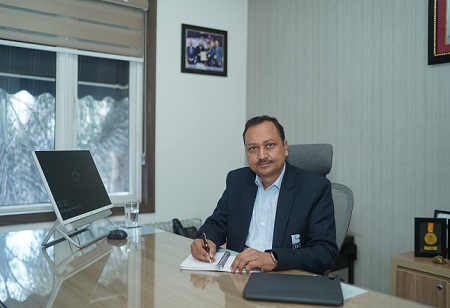
Dinesh Garg, Managing Director, Behari Lal Engineering in a recent interaction with Industry Outlook magazine shared his views on the feasible alternatives to coal-based blast furnaces that can significantly reduce carbon footprints in steel production, how the steel industry can overcome challenges to effectively integrate hydrogen as a sustainable alternative and more.
The reliance on coal in traditional blast furnaces continues to be a primary source of carbon emissions in steel manufacturing. What feasible alternatives to coal-based blast furnaces can significantly reduce carbon footprints in steel production?
Feasible alternatives to coal-based blast furnaces include Electric Arc Furnaces (EAFs) powered by renewable energy, hydrogen-based reduction methods, Natural Gas-based Direct Reduced Iron (DRI) processes and Biomass-based reduction methods.
Overall, electric arc furnaces (EAFs) and IFs have an advantage over traditional methods as the electric furnace can use 100 percent steel scrap as raw material and cut more than 50 percent carbon emissions, even while running on thermal power. In cases where Hydro, Wind and Solar are used as a power source, the carbon footprint reduces drastically.
The high cost and technical complexity of hydrogen-based reduction methods are major barriers to large-scale adoption in steel production. How can the steel industry overcome these challenges to effectively integrate hydrogen as a sustainable alternative?
To overcome the high cost and technical complexity of hydrogen-based reduction methods we should invest in research and development to improve efficiency and reduce costs, implement economies of scale through large-scale production, develop strategic partnerships to share knowledge and resources, and encourage government incentives and policies supporting hydrogen adoption.
Hydrogen as a power source is largely untapped due to high costs involved in the initial stage. Once the industry adopts and invests in the research development with the help of government incentives, large scale adaptability will surely happen, leading to a promising and greener future of Iron & Steel industry.
The lack of infrastructure for carbon capture and storage (CCS) limits the steel industry's ability to capture and mitigate emissions. How can the industry accelerate the development and implementation of CCS technology to minimize emissions in steel plants?
To accelerate CCS development and implementation we should collaborate with governments, research institutions, and industry partners, invest in CCS infrastructure development and demonstration projects, develop standardized CCS technologies and protocols and encourage regulatory frameworks supporting CCS adoption
Recently, the press releases released by some Primary Steel producers shed light on the steps taken for the implementation of CCS Technology. They have invested and signed MOUs with leading technology providers of steel making equipment to implement CCS technology in their existing plants.
The high energy demands of steel production make it difficult to transition to renewable energy sources without significant cost implications. How can the steel industry reduce its reliance on fossil fuels while managing the financial challenges of using renewable energy?
To reduce reliance on fossil fuels while managing financial challenges they should gradually transition to renewable energy sources, implement energy-efficient technologies and practices, develop strategic partnerships with renewable energy providers and encourage government incentives and policies supporting renewable energy adoption.
Reducing carbon footprint and minimizing environmental impact has become one of the primary objectives of the entire iron and steel industry. While it is important to balance profitability with renewable energy costs, investing in renewable energy would lead to long term environmental benefits, and would also help in backward integration by captive power consumption, making it a reliable source of energy.
The inefficiency in scrap steel recycling and the challenges of obtaining high-quality scrap are obstacles to reducing carbon emissions via electric arc furnaces (EAFs). What strategies can be implemented to improve scrap collection, sorting, and quality?
To improve scrap collection, sorting, and quality the following strategies can be implemented such as efficient scrap collection and sorting systems, develop strategic partnerships with scrap suppliers, invest in research and development to improve scrap quality and encourage closed-loop recycling practices
In the last few years after the Vehicle Scrappage policy was announced by the Union government, private players have set up innovative facilities in several states all over the country. The adaption of the policy is picking up pace, and it is expected that reliance on import will decrease. Currently, India is in a building stage with the rise of new infrastructure. However, in a few years’ time, this infrastructure will require replacement or repairing, and then India will also shift from Iron ore based production to electric furnaces.
The limited availability of skilled labour and technical expertise in low-carbon steel production methods hinders the industry's transition to greener practices. How can the steel industry address the skills gap to support the adoption of sustainable technologies?
To address the skills gap in low-carbon steel production methods steel industries must provide training and development programs for existing workforce, attract new talent with expertise in sustainable steel production, collaborate with educational institutions to develop specialized programs and encourage knowledge sharing and industry-wide best practices.
The Government and private sectors are collaborating to set up skill development centres. The Iron and Steel sector has experienced a steep growth curve, especially after the COVID-19 pandemic. The economy also went through a big gap between demand and supply, leading to setting up of industries and scaling up of operations across the country. Talent has been hired and given both on-the-job training and classroom training to learn the nuances of their job responsibilities. A skill matrix has also been prepared for various jobs to ascertain the required skill needed for a particular job, making the training process easier. The new generation of workforce is already environmentally conscious, and they, being future leaders, are driving the change for the better, bringing in a dawn of sustainable manufacturing. The industry is going green, not just because of the laws, but also out of a desire to leave a greener and better environment for the future generations to live in.
We use cookies to ensure you get the best experience on our website. Read more...